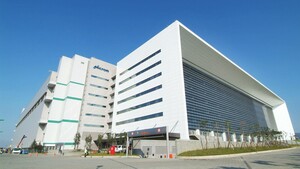AMD and Advanced Technology Investment Company of Abu Dhabi to Create New Leading-Edge Semiconductor Manufacturing Company
Mubadala increases investment in financially-stronger AMD, which is simultaneously unlocking the value of its manufacturing assets
“The Foundry Company” to build new state-of-the-art manufacturing facility in Upstate New York, creating more than 1,400 jobs, and to expand existing manufacturing facility in Dresden
IBM welcomes The Foundry Company into the IBM Alliance
NEW YORK— Oct. 7, 2008 — AMD [NYSE: AMD] and the Advanced Technology Investment Company (ATIC) of Abu Dhabi today announced the creation of a U.S.-headquartered, leading-edge semiconductor manufacturing company to address growing demand for independent, leading-edge foundry production capabilities. The new global company, to be temporarily called “The Foundry Company”, will serve this need by combining advanced process technology, industry-leading manufacturing facilities and aggressive plans to expand its global capacity footprint. At the same time, the Mubadala Development Company will increase its current investment in AMD to 19.3 percent on a fully diluted basis.
AMD will contribute to The Foundry Company its manufacturing facilities, including two fabrication facilities in Dresden, Germany, as well as related assets and intellectual property rights. ATIC will invest $2.1 billion to purchase its stake in The Foundry Company, of which it will invest $1.4 billion directly in the new entity and the remainder will be paid to AMD to purchase additional shares in The Foundry Company. The Foundry Company will also assume approximately $1.2 billion of AMD’s existing debt. ATIC has committed additional equity funding to The Foundry Company of a minimum of $3.6 billion and up to $6.0 billion over the next five years to fund the expansion of The Foundry Company’s chip-making capacity beyond the manufacturing facilities initially contributed by AMD. These funds will be used by The Foundry Company to (i) proceed with capacity expansion at its fabs in Dresden, Germany, including an upgrade of one of its fabs to a state-of-the-art facility, and (ii) begin construction on a new state-of-the-art facility in Saratoga County, New York, subject to the transfer of previously-approved New York State incentives. The New York facility is expected to create more than 1,400 direct jobs, and, through its operation, to generate an additional 5,000 jobs in the region. Once operational, the New York facility will be the only independently-managed, leading-edge semiconductor manufacturing foundry in the United States.
Global demand for independent foundry manufacturing is growing because leading semiconductor companies are exiting manufacturing, as the cost and complexity increases and capital and research and development costs have become too high. In addition, the world’s requirements for devices that use more advanced semiconductors continue to grow, and the IBM technology alliance, to which The Foundry Company will belong, creates an increasingly larger foundation for semiconductor innovation.
The Board of Directors of The Foundry Company will be equally divided between representatives of AMD and ATIC. AMD will own 44.4 percent and ATIC will own 55.6 percent of The Foundry Company’s fully-converted common stock upon its formation.
Doug Grose will relinquish his current role as AMD’s senior vice president of manufacturing operations to become chief executive officer of The Foundry Company. Hector Ruiz will relinquish his current role as AMD’s executive chairman and chairman of the board to become chairman of The Foundry Company. To augment its announced leadership, the new company plans an aggressive recruitment strategy to round out a world-class semiconductor manufacturing leadership team.
ATIC is an investment company formed by the government of Abu Dhabi to invest in advanced technology opportunities that require patient capital and long-term time horizons to achieve economic returns while also increasing the economic diversification of Abu Dhabi. While it enhances its capabilities specific to the transaction, ATIC will enter into a 12-month agreement with Mubadala to project manage ATIC’s interest in The Foundry Company.
As a result of the transactions, AMD will strengthen its financial position and focus on the design and development of innovative computing and graphics solutions. AMD will improve its liquidity through The Foundry Company’s assumption of approximately $1.2 billion in debt, ATIC’s $700 million payment to AMD for ownership interests in The Foundry Company and Mubadala’s $314 million paid to AMD for 58 million newly issued AMD shares and warrants for 30 million additional shares.
Mubadala, an existing 8.1 percent AMD shareholder, will increase its stake to 19.3 percent of outstanding AMD shares on a fully diluted basis. This will be accomplished through the purchase for $314 million of 58 million newly issued AMD shares and warrants for 30 million additional shares. Mubadala will also have the right to appoint a designee to AMD’s board of directors.
“Today is a landmark day for AMD, creating a financially stronger company with a tightened focus,” said Dirk Meyer, president and chief executive officer of AMD. “With The Foundry Company, AMD has developed an innovative way to focus our efforts on design while maintaining access to the leading-edge manufacturing technologies that our business needs without the required capital-intensive investments of semiconductor manufacturing. I particularly want to congratulate our Chairman Hector Ruiz, whose vision and leadership of our Asset Smart strategy is fulfilled today.”
“We are as enthusiastic about AMD’s potential today as we were when we made our initial investment last year,” said Khaldoon Al Mubarak, chief executive officer and managing director of Mubadala. “This increased investment is a strong vote of confidence in AMD’s Asset Smart business strategy, evolved leadership team, and best-in-class technology.”
“ATIC and AMD are the ideal partners with which to create The Foundry Company,” said Hector Ruiz, chairman of AMD’s board of directors, who will become chairman of The Foundry Company. “Working together allows us to combine ATIC’s long-term vision and patient capital with our manufacturing leadership, innovation and highly-skilled workforce. Moreover, The Foundry Company’s presence in Upstate New York alongside IBM and other research leaders will cement the region’s position as one of the world’s premier centers of nanotechnology development.”
ATIC Chairman Waleed Al Mokarrab said, “More than a year in the making, today’s announcement significantly reshapes the global semiconductor industry – it is an investment where all parties see significant opportunity. Independent and well-capitalized, The Foundry Company begins day one with an established leading-edge customer, an advanced technology roadmap, an R&D partnership with IBM, and a clear plan to scale capacity, providing it the foundation to become a clear leader in global semiconductor manufacturing.”
“The creation of The Foundry Company represents a critical milestone in the evolution of the semiconductor industry,” said Doug Grose, who will be the CEO of The Foundry Company. "Companies are eager for choice in the supply of leading-edge manufacturing capacity, and our new venture is answering that call. By combining operational excellence, leading-edge technology developed in collaboration with IBM, and an aggressive capacity roadmap, The Foundry Company aspires to drive the next round of innovation in this industry."
The Foundry Company will join the IBM joint development alliance for both silicon-on-insulator (SOI) and bulk silicon through the 22nm generation. The alliance consists of a group of leading semiconductor companies collaborating on next generation silicon technologies.
"We welcome The Foundry Company into the IBM alliance and are pleased to see the company investing in New York,” said Dr. John E. Kelly III, senior vice president and director of Research at IBM. “The Foundry Company’s membership in the alliance brings new intellectual capital to our collaborative effort and continues to build on the momentum and leadership that the alliance has established in semiconductor technologies."
Upon closing of the transaction, The Foundry Company will commence operations with approximately 3,000 employees who will transition into the new company from AMD facilities in Silicon Valley, New York, Dresden, and Austin. The new company’s principal headquarters will be in Silicon Valley and its research and development and manufacturing leadership teams and ecosystems will be based in New York, Dresden, and Austin. After the upgrade and expansion in Dresden and the build-out of the New York facility, The Foundry Company envisions expanding its global manufacturing footprint over time, if commercially justified, to also include new fabrication facilities in Abu Dhabi.
The transaction is expected to close at the beginning of 2009 following satisfaction of conditions such as approvals from regulators, transfer of previously-confirmed New York incentives to The Foundry Company, and the approval of AMD stockholders for the issuance of common stock and warrants to Mubadala. Prior to closing, AMD, ATIC and Mubadala will file a joint voluntary notice of the transaction for review by the Committee on Foreign Investment in the United States (CFIUS), a government inter-agency committee chaired by the Secretary of the Treasury.
Dresden/Germany site specifics:
AMD‘s Dresden manufacturing operations rank among the most successful leading-edge semiconductor production facilities in the world. In the 300mm wafer manufacturing plant, Fab 36, AMD produces its microprocessor product portfolio using advanced 65nm and 45nm technologies. The former 200mm facility, Fab 30, is being transformed into Fab 38, a state-of-the-art 300mm facility, which will be ramped for production in 2009. At present AMD employs about 2,800 highly qualified engineers, technicians and specialists in Dresden.
The Dresden manufacturing site is one of largest international investments in Germany over the past decade. Total investment in the two facilities, Fab 36 and Fab 38, is approximately $ 6 billion. In addition, AMD has entered into industry-leading joint ventures AMTC and CNT: The Advanced Mask Technology Center (AMTC) focuses on the development and pilot production of next-generation lithographic masks. The Center of Nanoelectronic Technology (CNT) develops highly innovative process solutions based on 300mm wafer manufacturing.
The company has helped to establish the larger Dresden region as Europe’s leading center of micro- and nanoelectronics with currently more than 44,000 employees in 1,200 high-tech companies and research institutions.
“This is a great day for us in Dresden. With the announcement of The Foundry Company, AMD Dresden becomes the cornerstone of a new global semiconductor manufacturing leader,” said Dr. Hans Deppe, Corporate Vice President and General Manager, AMD Dresden. “We are entering an exciting new phase of our business in which we complete the 300mm expansion of Fab38 and fully unlock the potential of Dresden for the whole market to see. Without a doubt, the creation of The Foundry Company will further strengthen the Saxony region as Europe's leading semiconductor cluster.”
Upon closing, The Foundry Company will:
- Have a total enterprise value of $5.0 billion, consisting of AMD's contribution of manufacturing assets and intellectual property (including its fabrication facilities in Dresden), intellectual capital and employees valued together at $2.4 billion; ATIC's contribution of $1.4 billion in new capital; and $1.2 billion of debt assumed by The Foundry Company from AMD;
- Be consolidated with AMD for purposes of financial reporting;
- Have a board of directors whose membership is equally divided between representatives of AMD and ATIC;
- Have only AMD and ATIC as stockholders, each of which at the closing will have equal voting rights;
- Be owned 44.4 percent by AMD and 55.6 percent by ATIC on a fully converted to common basis. ATIC’s economic ownership will increase over time based on the differences in securities held by AMD and ATIC, and depending on whether AMD elects to invest proportionately with ATIC in future capital infusions to support The Foundry Company’s growth;
- Have its principal headquarters in Silicon Valley, and its research and development and manufacturing leadership teams and ecosystems in New York, Dresden, and Austin;
- Have an exclusive supply agreement with limited exceptions to manufacture AMD processors and to manufacture, where competitive, certain percentages of other AMD semiconductor products;
- Begin construction of the Fab 4X manufacturing facility in New York in the middle of 2009, directly employing more than 1,400 workers in Upstate New York when the facility is in full operation;
- Expect to increase capacity through completing the 300mm conversion of a second state-of-the-art facility in Dresden in 2009;
- Join the IBM technology development alliance for both SOI and bulk silicon technology, greatly expanding the addressable market of The Foundry Company;
- After the upgrade and expansion in Dresden and the build-out of the New York facility, The Foundry Company envisions expanding its global manufacturing footprint over time, if commercially justified, to also include new fabrication facilities in Abu Dhabi; and
- Announce its permanent corporate name and identity.
Upon closing, AMD will:
- Have equal voting rights with ATIC in The Foundry Company;
- Own 44.4 percent of The Foundry Company on a fully converted to common basis;
- Improve its liquidity through The Foundry Company’s assumption of approximately $1.2 billion of AMD’s debt, ATIC’s $700 million payment to AMD for ownership interests in The Foundry Company and Mubadala’s purchase for $314 million of 58 million newly issued AMD shares and warrants for 30 million additional shares;
- Tightly focus on the design and development of the next generation of innovation based on the fusion of computing and graphics processing;
- Elect a Mubadala designee as a member of its board of directors;
- Excluding its consolidation of The Foundry Company for financial reporting purposes, improve its net cash position by $2.1 billion, through The Foundry Company’s assumption of approximately $1.1 billion in debt (net of approximately $100 million cash transferred by AMD to The Foundry Company) and cash payments from ATIC and Mubadala aggregating $1.0 billion;
- Have the option, but not any requirement, to provide additional capital funding to The Foundry Company in response to future capital calls; and
- Have an exclusive supply agreement with The Foundry Company, with limited exceptions, to manufacture AMD processors and to manufacture, where competitive, certain percentages of other AMD semiconductor products.
Upon closing, ATIC will:
- Have equal voting rights with AMD in The Foundry Company;
- Own 55.6 percent of The Foundry Company on a fully converted to common basis;
- Invest an initial $2.1 billion, of which $1.4 billion will be invested directly in the new company and $700 million will be paid directly to AMD;
- Commit a minimum of $3.6 billion and up to $6.0 billion in additional funds over the next five years for the upgrade and expansion of fabrication facilities in Dresden and construction of a new facility in Upstate New York.
Upon closing, Mubadala will:
- Purchase for an aggregate of $314 million 58 million newly issued AMD shares and warrants for 30 million additional shares, giving it a total stake in AMD of 19.3 percent on a fully diluted basis; and
- Have a right to designate a representative for election as a member of the board of directors of AMD.
For more information on the announcement, visit
http://www.amd.com/NewGlobalFoundry



